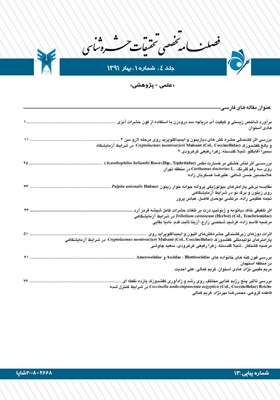بررسی اثر تنش خشکی بر خسارت مگس Acanthophilus helianthi Rossi (Dip., Tephritidae) روی سه رقم گلرنگ، .Carthamus tinctorius L در منطقه تهران
محورهای موضوعی : حشره شناسی و سایر بندپایانغلامحسین حسن شاهی 1 , علیرضا عسکریان زاده 2
1 - گروه گیاه پزشکی، دانشکده علوم کشاورزی، دانشگاه شاهد، تهران
2 - گروه گیاه پزشکی، دانشکده علوم کشاورزی، دانشگاه شاهد، تهران
کلید واژه: تنش خشکی, Drought stress, cultivar, ارقام گلرنگ, مگس گلرنگ, آلودگی قوزه, Safflower safflower Fly, Infested boll,
چکیده مقاله :
در این مطالعه، اثر تنش خشکی بر خسارت مگس Acanthophilus helianthi Rossi (Dip., Tephritidae) روی سه رقم گلرنگ، .Carthamus tinctorius L در سال 1390 در منطقه تهران بررسی شد. این آزمایش به صورت کرت های خرد شده در قالب طرح پایه کاملا تصادفی اجرا شد. تیمارهای آزمایشی شامل آبیاری کامل، تنش متوسط خشکی و تنش شدید خشکی به عنوان کرت اصلی و ارقام گلرنگ مورد بررسی گلدشت، پدیده و C44 به عنوان کرت فرعی بودند. درصد قوزه های آلوده و وزن دانه ها در کرت های آزمایشی نمونه برداری شد. نتایج نشان داد که درصد قوزه های آلوده در تنش های خشکی در سطح 1% اختلاف معنی داری داشتند. همچنین بین درصد آلودگی قوزه در ارقام مختلف اختلاف معنی داری وجود داشت. بیشترین درصد آلودگی قوزه در تیمار تنش شدید خشکی (44/69) و کمترین درصد آلودگی قوزه در تنش متوسط خشکی (94/56) به دست آمد. بیشترین درصد آلودگی قوزه در رقم پدیده (05/68) و کمترین درصد آلودگی قوزه در رقم گلدشت (09/50) مشاهده گردید. بر اساس نتایج این آزمایش در شرایط بدون تنش رقم گلدشت نسبت به دو رقم دیگر برتری داشت در حالی که رقم پدیده برای کاشت در شرایط تنش خشکی گزینه بهتری می باشد. اما به طورکلی رقم گلدشت به عنوان مقاوم ترین رقم در بین سه رقم شناخته شد. همچنین در این رقم آلودگی قوزه باعث افزایش وزن دانه های سالم شده زیرا وزن هزار دانه سالم در قوزه آلوده بیشتر از وزن هزار دانه سالم در قوزه سالم بود. لذا احتمال پدیده جبران در این رقم نسبت به خسارت مگس گلرنگ دیده می شود.
The effect of drought stress on damage of safflower fly, Acanthophilus helianthi Rossi (Dip., Tephritidae) was compared on three cultivars of safflower, Carthamus tinctorius L. by an experiment in split plot arrangement in completely randomized design in 2011. Where levels of irrigation including complete irrigation during whole growing season (S1), cutting irrigation at flowering stage (S2) and cease irrigation at heading stage (S3) as main plot, and safflower cultivars including Goldasht, Padideh and C44 as sub-plot. Percentage of infested boll and seed weight were sampled in the experimental plots. Results indicated a significant difference at 1% level in percentage of infested bolls among drought stresses. Also, percentage of infested boll and 1000-seed weight in healthy boll had significant difference among cultivars. The highest and lowest percentage of infested boll belonged to S3 (69.44%) and S2 (65.94), respectively. The highest and lowest percentage of infested boll belonged to Padideh cultivar (68.05%) and Goldasht cultivar (50.09%). Results showed that in non-stress conditions, Goldasht has the best growth and resistance to safflower fly, while in drought stress conditions, Padideh is the best alternative but overall Goldasht was cultivar recognized as the most resistant in among of three cultivars. In this cultivar, damage of some seeds in a boll increased 1000-seed weight in healthy seed of the boll because 1000-seed weight in infested boll is more than healthy 1000-seed weight in infested boll. It is probable that compensation phenomenon in Goldasht cultivar appears against safflower fly damage.


